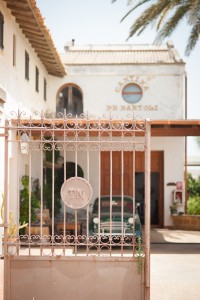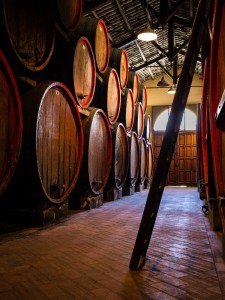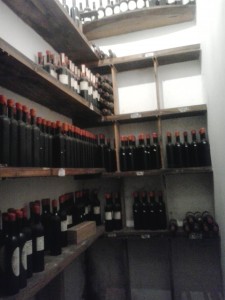

When we think about Sherry, Port and Madeira wines, it is quite easy to associate them with the idea of quality and preciousness. But when we try to do the same with Marsala, we tend to consider it as a cheaper and lower quality brother of Sherry, good ingredient for cooking. Such preconception is undoubtedly due to what Marsala wine has been known for worldwide since the 20th century, when many sweetened and aromatised versions were created to satisfy questionable commercial policies focused on easy and fast economic returns. But believe me, a really true Marsala wine stands out today thanks to a Sicilian man who fiercely fought against its decline: Marco de Bartoli.
Last July I had the chance to visit the De Bartoli’s winery, located 12km far from the town of Marsala, in the Western part of Sicily. The winery is inside an old Sicilian baglio, a term which designates a historical feudal hamlet, once used as agricultural and viticulture production centre, around which a small community of workers and land owners lived.


The baglio was inherited by Marco from his grandmother, descendent of another big family of Marsala wines producers (Pellegrino), and it is the place where he decided to start his wine revolution in 1980s. At that time, Marsala wine was in big decline: it was a commercial product made by fortification of the base wine with cooked mistella (cooked must added as a sweetening and concentration agent and grape brandy). Its use was mainly culinary and even the best expressions couldn’t reveal high quality levels, being devoted to mass production.
As often happens, the desire of big commercial returns downgraded the quality and the image of Marsala. Something that Marco De Bartoli couldn’t accept. He was a passionate man, tenacious and firm, advocating for a return to the origins, to rediscover the real value of local wine tradition. His main purpose was to dignify again the wine of Marsala. The first experiment he made was buying old wines left in oblivion in old bagli in order to restore them with the addition of new wine. Such wines had been produced through the in perpetuum method, very similar to the Spanish Solera system. Through a continuous process of drawing off and refilling a defined amount of the old wine with younger wine for many years, the final wine resulted into a concentrated unfortified nectar rich in alcohol and blend of different vintages. This was the method used by local farmers before the British introduced fortification in the Marsala wine.

Later, De Bartoli decided to focus on native single-varietal wines starting the production in Samperi. Relying on the in perpetuum, he created a wine made by 100% late-harvested Grillo grapes, unfortified and with a high level of alcohol, perfectly suitable to age in casks for years magnificently. He called it Vecchio Samperi, to distinguish his wine as the expression of the terroir (Samperi area) from the rest of Marsala wines. According to the DOC system, Marsala can be made from a blend of four grapes: Inzolia, Catarratto, Grillo and Damaschino. The first two grapes are usually preferred by producers because of their high yielding oriented to a more commercial production. Unfortunately, the base wine has a natural level of alcohol of 12% abv and grape brandy is added in order to reach the 17.5-18% abv prescribed by the regulation. By focusing mainly on Grillo, Marco De Bartoli made the hardest choice: this variety is low-yielding and not so easy to grow, but it has natural advantages such as good level of acidity and high sugars content. The resulting base wine is naturally high in alcohol, not needing fortification then, concentrated and suitable for barrel ageing as the grape is also prone to oxidation. Furthermore, it can be the real expression of the terroir where it is grown. I was really surprised to see the soil where Samperi wines are produced: a calcareous tufa, rich in minerals and limestone with visible marine fossils and shells. One of the key factors for the finesse of the wines.
Vecchio Samperi received big acclaim from the critics: it was unique as his tenacious producer. Marsala wines followed, produced from in perpetuum base wines to which fresh mistella made with fresh musts and brandy from the same grapes is added for fortification after fermentation still today. The wines are then aged in Solera system. Their quality level is amazing, proving that his producer was right in considering the quality of the grape and the ageing the key factors for outstanding products. As Marco De Bartoli said, “time is the key ingredient to making Marsala”.
The same revolutionary approach is applied to the production of Passito. Half of the grapes are sundried on mats near small walls made of volcanic stone. These not only protect the berries from the hot winds, but also contribute to the drying process by releasing the accumulated heat of the day at nigh time. The other half of the berries is left to dry on the vine for late-harvesting. After fermentation, the dried berries are added to the base wine to macerate for three months until reaching a perfect balance between residual sugars and alcohol.
A dry white wine from 100% Zibibbo grapes, Pietranera, is also produced, after selecting berries from the northernmost, shaded areas to obtain greater acidity and lower sugar content. Another innovation in the wine tradition of Pantelleria.
Today the winery is still family-owned. Marco’s children proudly keep the father’s beliefs alive, also promoting organic viticulture and natural vinification.
At the end of my visit, I could taste seven wines from De Bartoli’s range. I was really amazed by their outstanding quality and their vibrancy. It was impossible to make a ranking of preference! The terroir and grapes are perfectly expressed as the personality of their creator. Have a look at my tasting notes to get an idea.
For more information about how to visit the winery, please have a look at Marco De Bartoli’s site.
I would particularly like to thank Marilena Leta, Communication and PR Manager at De Bartoli, for her professional guide and support. All the pictures are Marco De Bartoli’s courtesy.

Pietranera 2013, Pantelleria Bianco DOC
100% Zibibbo
12% abv
Medium lemon dry white wine, intensely aromatic and strongly mineral with touch of salinity. Notes of dried apricots, honey and hints of earth give way to a vibrant and refreshing mouthfeel thanks to a good level of natural acidity and a well-integrated alcohol. This elegant and persistent wine is produced after a manual selection of the grapes, destemming and gentle pressing and a cold maceration for 24 hours. After resting for two days at low temperatures in order to keep the fruitiness and freshness of the grapes, the fermentation starts in stainless steel vessels with temperature control. Six months of ageing in tanks follow.

Grappoli del Grillo 2013, Grillo IGT Terre Siciliane
100% Grillo
12% abv
Medium lemon dry white wine, well-balanced and structured with lively acidity and creamy, subtle texture deriving from lees contact. Delicate notes of green apples and fresh herbs are followed by mineral and salty hints. Characterful with a long and clean finish, a perfect pairing to strong-flavoured dishes. The wine is fermented with wild yeasts at controlled temperatures in stainless steel vessels after being gently pressed and cold decanted for 48 hours. It goes through 12 months of lees ageing in French oak barrels and 6 months in bottle. You can drink it now, although having a good ageing potential of additional 3-5 years from the date of release.

Rosso di Marco 2013, Pignatello Terre Siciliane IGT
100% Pignatello
12% abv
Brilliant pale ruby wine made from Pignatello grapes, also known as Perricone, a grape native to Trapani and Palermo area. Fruity notes of ripe cherry and blackberry and hints of spicy black pepper characterise this pleasant red wine, together with soft silky tannins, medium body and medium acidity. The delicate alcohol is well-integrated, resulting into a refreshing final mouthfeel. After being fermented with wild yeasts, the wine ages 12 months in Frenck oak and 6 months in bottle before being released. Best drunk while young.

Vecchio Samperi Ventennale, Vino Liquoroso Secco
100% Grillo
17.5% abv
Pale amber dry white, with an impressive aromatic intensity of almonds and hazelnuts, raisins and figs and a touch of tanginess on the palate. Its vibrant structure and the complex, mouthcoating texture are determined by an almost zesty acidity, a medium body and a warming well-integrated alcohol. Chewy endless finish, reminding the best Amontillado Sherries. After being manually picked and selected, the grapes are gently pressed and decanted naturally. Fermented at room temperatures in oak and chestnut barrels, the wine is then aged through the in perpetuum method with no fortification. The average age of the blend is 20 years. Good as aperitif, wonderful companion to food or even after dinner.

Vigna La Miccia, Marsala Superiore Oro DOC Riserva 5 years
100% Grillo
18% abv
This clean pale amber off-dry Marsala represents the fruitier and delicate expression of the De Bartoli’s Marsalas. White fruits and almonds notes stand out clearly in this straight forward wine, with a good level of acidity and a precise structure. The gentle alcohol is well-integrated. Refreshing aftertaste. The wine is cold vinified and fortified during fermentation. It is aged in anaerobic conditions over 4 years in new French oak, always topped up. It spends 6 months in bottle before being released.

Marsala Superiore Oro DOC Riserva 10 years old
100% Grillo
18.5% abv
Medium amber and medium dry Marsala, with intense notes of figs, dates, orange peel and dried apricots. Touches of candied fruits and saltiness on the palate. The refreshing acidity, the medium body and the warming well-integrated alcohol contribute to its finesse and elegance. Persitent and impressive, a good companion to the end of a meal. The hand-picked and selected grapes are fermented at room temperature in oak and chestnut barrels, after being gently pressed and naturally decanted. Part of the must is enriched with mistella from fresh Grillo grapes and fortified with brandy of the same variety. The wine is then aged 10 years in oaks.

Bukkuram Sole d’Agosto, Passito di Pantelleria DOC
100% Zibibbo
14.5% abv
This medium gold and sweet wine is the younger and fresher version of De Bartoli’s Passito. Fruity and vibrant, with no stickiness thanks to the nervy acidity, it reveals delicate notes of candied oranges, raisins and honey together with balsamic scent of rosemary and laurel. Velvety texture and long, pleasant finish. The wine is produced by sun-dried Zibibbo grapes and overripe berries left on the vine until mid-September. Once fermentation starts, the dried berries are added to the base wine for 3 months maceration. The wine is left to age 6 months in stainless steel tanks and 6 months in French oak barrels.
This site uses functional cookies and external scripts to improve your experience.
Privacy settings
Privacy Settings
This site uses functional cookies and external scripts to improve your experience. Which cookies and scripts are used and how they impact your visit is specified on the left. You may change your settings at any time. Your choices will not impact your visit.
NOTE: These settings will only apply to the browser and device you are currently using.
Google Analytics
Google Analytics is a website traffic analysis application that provides real-time statistics and analysis of user interaction with the website. Google analytics enables website owners to analyze their visitors, with the objective of interpreting and optimizing website’s performance.